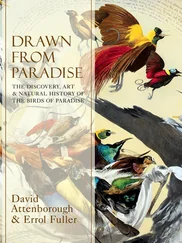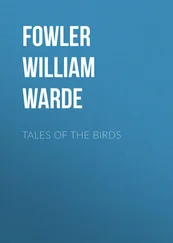William Fowler - A Year with the Birds
Здесь есть возможность читать онлайн «William Fowler - A Year with the Birds» — ознакомительный отрывок электронной книги совершенно бесплатно, а после прочтения отрывка купить полную версию. В некоторых случаях можно слушать аудио, скачать через торрент в формате fb2 и присутствует краткое содержание. Жанр: foreign_antique, foreign_prose, на английском языке. Описание произведения, (предисловие) а так же отзывы посетителей доступны на портале библиотеки ЛибКат.
- Название:A Year with the Birds
- Автор:
- Жанр:
- Год:неизвестен
- ISBN:нет данных
- Рейтинг книги:4 / 5. Голосов: 1
-
Избранное:Добавить в избранное
- Отзывы:
-
Ваша оценка:
- 80
- 1
- 2
- 3
- 4
- 5
A Year with the Birds: краткое содержание, описание и аннотация
Предлагаем к чтению аннотацию, описание, краткое содержание или предисловие (зависит от того, что написал сам автор книги «A Year with the Birds»). Если вы не нашли необходимую информацию о книге — напишите в комментариях, мы постараемся отыскать её.
A Year with the Birds — читать онлайн ознакомительный отрывок
Ниже представлен текст книги, разбитый по страницам. Система сохранения места последней прочитанной страницы, позволяет с удобством читать онлайн бесплатно книгу «A Year with the Birds», без необходимости каждый раз заново искать на чём Вы остановились. Поставьте закладку, и сможете в любой момент перейти на страницу, на которой закончили чтение.
Интервал:
Закладка:
Christchurch Meadow is a favourite home of the Titmice. I believe that I have seen all the five English species here within a space of a very few days: English, not British, for there is one other, the Crested Tit, of which I shall have more to say in another chapter. A family of Longtails, or Bottle-tits, flits from bush to bush, never associating with the others, and so justifying its scientific separation from them. Another family is to be seen in the Parks, where they build a nest every year. These delightful little birds are however quite willing to live in the very centre of a town, indifferent to noise and dust. A Marsh-tit was once seen performing its antics on a lamp-post in St. Giles. A Great-tit built its nest in the stump of an old laburnum, in the little garden of Lincoln College, within a few yards of the Turl and High Street; the nest was discovered by my dog, who was prowling about the garden with a view to cats. I took great interest in this brood, which was successfully reared, and on one occasion I watched the parents bringing food to their young for twenty minutes, during which time they were fed fourteen times. The ringing note of this Great-tit or his relations is the first to be heard in that garden in winter-time, and is always welcome. The little Blue-tit is also forthcoming there at times. One Sunday morning I saw a Blue-tit climbing the walls of my College quadrangle, almost after the manner of a Creeper, searching the crannies for insects, and even breaking down the crust of weathered stone. Among memories of the rain, mist, and hard work of many an Oxford winter spent among these gray walls, “haec olim meminisse juvabit.”
But I have strayed away from Christchurch Meadow and the Botanic Garden. Here it is more especially that the Thrush tribe makes its presence felt throughout the autumn. In the Gardens the thrushes and blackbirds have become so tame from constant quiet and protection, that, like the donkeys at Athens of which Plato tells us, they will hardly deign to move out of your way. A blackbird proceeded calmly to take his bath, in the fountain at the lower end near the meadow, one morning when I was looking on, and seemed to be fully aware of the fact that there was a locked gate between us. Missel-thrushes are also to be seen here; and all these birds go out of a morning to breakfast on a thickly-berried thorn-bush at the Cherwell end of the Broad Walk, where they meet with their relations the Redwings, and now and then with a Fieldfare. The walker round the meadow in winter will seldom fail to hear the harsh call of the redwing, as, together with starlings innumerable, and abundance of blackbirds, they utter loud sounds of disapproval. There is one bush here whose berries must have some strange ambrosial flavour that blackbirds dearly love. All the blackbirds in Oxford seem to have their free breakfast-table here, and they have grown so bold that they will return to it again and again as I teasingly walk up and down in front of it, merely flying to a neighbouring tree when I scrutinize them too closely in search of a lingering Ring-ousel. Who ever heard of a flock of blackbirds? Here, however, in November, 1884, was a sight to be seen, which might possibly throw some light on the process of developing gregarious habits. 9 9 At Lulworth, in Dorset, when the berry-season begins, I have noticed that the blackbirds will congregate on the hedgerows in considerable numbers, and abandon for a time their skulking habits. This makes it often difficult to distinguish them at a distance from the Ring-ousels, which are there about the same time.
Rooks, Starlings, Jackdaws, and Sparrows, which abound here and everywhere else in Oxford, every one can observe for themselves, and of Sparrows I shall have something to say in the next chapter; but let me remind my young readers that every bird is worth noticing, whether it be the rarest or the commonest. My sister laughs at me, because the other day she found an old copy of White’s Selborne belonging to me, wherein was inscribed on the page devoted to the Rook, in puerile handwriting, the following annotation: “Common about Bath” (where I was then at school). But I tell her that it was a strictly accurate scientific observation; and I only wish that I had followed it up with others equally unimpeachable.
But more out-of-the-way birds will sometimes come to Oxford, and I have seen a Kestrel trying to hover in a high wind over Christchurch Meadow, and a Heron sitting on the old gatepost in the middle of the field. Herons are often to be seen by the river-bank in Port Meadow; and it was here, some years ago, that Mr. W. T. Arnold, of University College, was witness of an extraordinary attack made by a party of three on some small birds. Port Meadow constantly entices sea-birds when it is under water, or when the water is receding and leaving that horrible slime which is so unpleasant to the nose of man; and in fact there is hardly a wader or a scratcher (to use Mr. Ruskin’s term) 10 10 I.e. for the Rasores , in Love’s Meinie ; where are some of the most delightfully wilful thoughts about birds ever yet published.
that has not at one time or another been taken near Oxford. Sometimes they come on migration, sometimes they are driven by stress of weather. Two Stormy Petrels were caught at Bossom’s barge in the Port Meadow not long ago, and exhibited in Mr. Darbey the birdstuffer’s window. And a well-known Oxford physician has kindly given me an interesting account of his discovery of a Great Northern Diver, swimming disconsolately in a large hole in the ice near King’s Weir, one day during the famous Crimean winter of 1854-5; this splendid bird he shot with a gun borrowed from the inn at Godstow. During the spring and early summer of 1866, our visitors from the sea-coast were constant and numerous. Even the beautiful and graceful little Tern ( Sterna Minuta ) more than once found his way here; and on the second occasion saved his own life by the confidence which he seemed to repose in man. ‘I intended to shoot it,’ wrote a young friend of mine, ‘but relented when I saw how tame and trustful it was.’
Specimens of almost all such birds are to be seen in the bird-cases of the Museum, and occasionally they may be seen in the flesh in the Market. Both Market and Museum will give plenty to do on a rainy day in winter: —
Ubi jam breviorque dies et mollior aestas
Quae vigilanda viris!
CHAPTER II.
OXFORD: SPRING AND EARLY SUMMER
All the birds mentioned in the last chapter are residents in Oxford, in greater or less numbers according to the season, except the Fieldfares and Redwings, the Grey Wagtail, and the rarer visitors: and of these the Fieldfares and Redwings are the only true winter birds. They come from the north and east in September and October, and depart again in March and April. When we begin our Summer Term not one is to be seen. The berries in the meadow are all eaten up long before Lent Term is over, and though these are not entirely or even chiefly the Redwing’s food, the birds have generally disappeared with them.
They do not however leave the country districts till later. When wild birds like these come into a town, the cause is almost certain to be stress of weather; when the winter’s back is broken, they return to the fields and hedges till the approach of summer calls them northwards. There they assemble together in immense flocks, showing all the restlessness and excitement of the smaller birds that leave us in the autumn; suddenly the whole mass rises and departs like a cloud. Accounts are always forthcoming of the departure of summer migrants, and especially of the Swallows and Martins, and there are few who have not seen these as they collect on the sunny side of the house-roof, or bead the parapet of the Radcliffe building, before they make up their minds to the journey. But few have seen the Fieldfares and Redwings under the same conditions, and I find no account of their migration, or at least of what actually happens when they go, in any book within my reach as I write. But on March 19, 1884, I was lucky enough to see something of their farewell ceremonies. I was walking in some water-meadows adjoining a wood, on the outskirts of which were a number of tall elms and poplars, when I heard an extraordinary noise, loud, harsh, and continuous, and of great volume, proceeding from the direction of these trees, which were at the time nearly half-a-mile distant. I had been hearing the noise for a minute or two without attending to it, and was gradually developing a consciousness that some strange new agricultural instrument, or several of them, were at work somewhere near, when some Fieldfares flew past me to alight on the meadow not far off. Then putting up my glass, I saw that the trees were literally black with birds; and as long as I stayed, they continued there, only retreating a little as I approached, and sending foraging detachments into the meadow, or changing trees in continual fits of restlessness. The noise they made was like the deep organ-sounds of sea-birds in the breeding-time, but harsher and less serious. I would willingly have stayed to see them depart, but not knowing when that might be, I was obliged to go home: and the next day when I went to look for them, only a few were left.
Читать дальшеИнтервал:
Закладка:
Похожие книги на «A Year with the Birds»
Представляем Вашему вниманию похожие книги на «A Year with the Birds» списком для выбора. Мы отобрали схожую по названию и смыслу литературу в надежде предоставить читателям больше вариантов отыскать новые, интересные, ещё непрочитанные произведения.
Обсуждение, отзывы о книге «A Year with the Birds» и просто собственные мнения читателей. Оставьте ваши комментарии, напишите, что Вы думаете о произведении, его смысле или главных героях. Укажите что конкретно понравилось, а что нет, и почему Вы так считаете.












